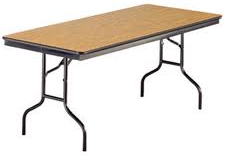After 20 years of selling stuff out of a full sized 10×10 display, table top trade show displays just bug the crap out of me.
Church bazaars (no offense meant) set out tables for people to set out the stuff they made and are trying to sell. Professional craftsmen (and professionals in business) spend time thinking about how to best show what they made. They think about the story they want to tell about their products.
Think Tiffany window display vs. T J Maxx windows
Here are a few things I learned selling from a 10×10 booth:
- Your display is not only about professionally-made stand-up banners (and I am not dismissing them). But people will NOT read all that copy. If I’m standing there, wouldn’t you rather tell me a story about your service and how it can benefit me? Not stand around waiting for me to finish reading?
- Put your sign high enough behind your display so as to be seen from the end of the aisle. Why?

Nobody can miss this business name from the end of the row! - If the sign is hanging on the front of your table, people crowding in front of your booth hide your name with their knees. If it’s high, they can look up and see your name without stepping back to read it. (Allowing/encouraging stepping back signals it’s ok to leave)
- The “be backs” (people who tell you , “I’ll be back later”) can look down the aisle and find you.
-

This kind works. Other shaped legs don’t. Drape your table to the floor. It’s not only hiding what visitors shouldn’t see, it’s also about presenting a uniform clean front view.
- Raise your table to counter height so people—especially vain women who don’t’ like to wear their glasses—can see what’s they’re looking at. An easy way to do this is to carry with you 4 pieces of PVC pipe about 14″ long that you can slip over the table legs (IF they have those U shaped legs like the table shown. It won’t work on the legs that are slanted)
- Bring something to change the heights of stuff on your table. Covered cardboard boxes (with something heavy inside) allows you to make important stuff higher than the rest of what you’re showing.
- Bring flowers or a plant. Have a bowl of candy. Don’t make a candy display that people are afraid to disturb. Get a pretty bowl they can stick their hand in and take a piece or two. Flowers are pretty and attract the eye. A bowl of candy gives a person a reason to stay and talk. People get embarrassed grabbing your candy and then walking away.
- If you can have lights (which is less likely at a table top kind of event than at a pipe and drape event) don’t skimp! No lights means no one is home so there’s no reason to stop and look.
- Don’t sit behind your table. It’s a barrier between you and your visitors. If you must have a chair (and I am not arguing for standing all day!) bring a tall, bar-height director’s chair.People don’t want to think they’re putting you out by asking you to stand. And why would you want your customers to look down on you?
- And perhaps most importantly, think about how people will look at your booth. They won’t see it all at once. They’ll see a piece, a piece, a piece.Think about the story you want to tell when someone stops.
- Never start with a question that can be answered “no.” For example: “Can I help you?” leads to “No, thanks, just looking.” And now you have to overcome that negative to get to a positive. How about: “Can I tell you a story about my product/service?” A small first agreement leads to later bigger agreement and sale. Once you know the story you can tell it over and over and be confident. Even if it bores YOU to death, each new visitor will hear it for the first time.
If you’re looking for ideas, visit any high end craft show and pay attention to the booths. (It’s a cheaper experience that way, but the craftsmen might not like it much!)
[kerch]








 Here’s a guy who might also be a coach to professionals. But I feel like I know more about him. From the frames in the background, I think he’s got some kind of training. And it looks like he’s easily talking to someone sitting across from him. He’s comfortable.
Here’s a guy who might also be a coach to professionals. But I feel like I know more about him. From the frames in the background, I think he’s got some kind of training. And it looks like he’s easily talking to someone sitting across from him. He’s comfortable.

 What says “fun” better than puppies?
What says “fun” better than puppies? What happens when the PDF you want to send is just too big?
What happens when the PDF you want to send is just too big?
 Did you ever notice how all those beer commercials at the Super Bowl are about good times? “Miller time” isn’t about cheap beer.
Did you ever notice how all those beer commercials at the Super Bowl are about good times? “Miller time” isn’t about cheap beer. Did you ever get one of these shirts after somebody’s vacation. “My mom and dad went to Hawaii and all I got was this lousy t-shirt?”
Did you ever get one of these shirts after somebody’s vacation. “My mom and dad went to Hawaii and all I got was this lousy t-shirt?” Smart people generally don’t like to admit when something baffles them. And competent people don’t like to admit being afraid of inanimate objects.
Smart people generally don’t like to admit when something baffles them. And competent people don’t like to admit being afraid of inanimate objects.